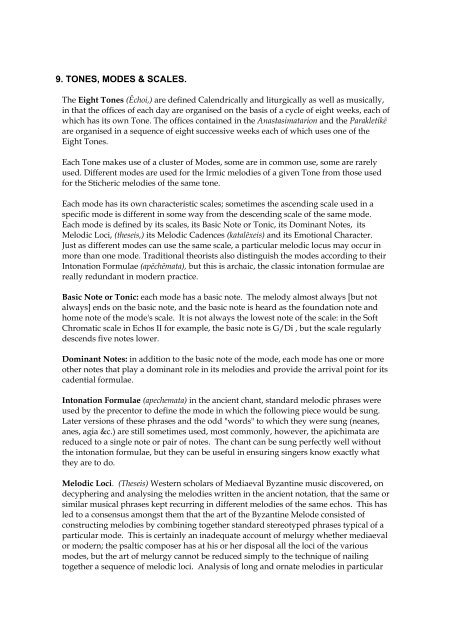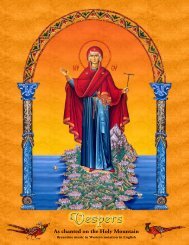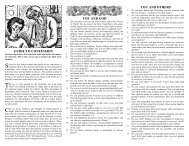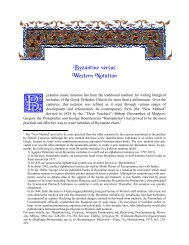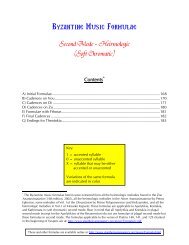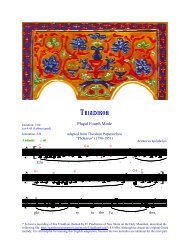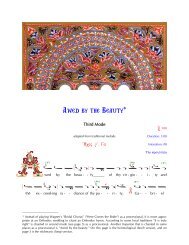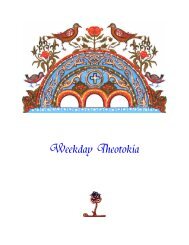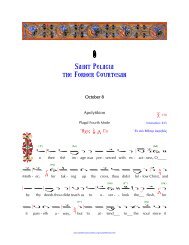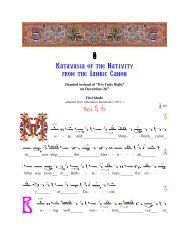Reading Psalmodia (PDF) - St. Anthony's Monastery
Reading Psalmodia (PDF) - St. Anthony's Monastery
Reading Psalmodia (PDF) - St. Anthony's Monastery
Create successful ePaper yourself
Turn your PDF publications into a flip-book with our unique Google optimized e-Paper software.
9. TONES, MODES & SCALES.The Eight Tones (Ēchoi,) are defined Calendrically and liturgically as well as musically,in that the offices of each day are organised on the basis of a cycle of eight weeks, each ofwhich has its own Tone. The offices contained in the Anastasimatarion and the Parakletikēare organised in a sequence of eight successive weeks each of which uses one of theEight Tones.Each Tone makes use of a cluster of Modes, some are in common use, some are rarelyused. Different modes are used for the Irmic melodies of a given Tone from those usedfor the <strong>St</strong>icheric melodies of the same tone.Each mode has its own characteristic scales; sometimes the ascending scale used in aspecific mode is different in some way from the descending scale of the same mode.Each mode is defined by its scales, its Basic Note or Tonic, its Dominant Notes, itsMelodic Loci, (theseis,) its Melodic Cadences (katalēxeis) and its Emotional Character.Just as different modes can use the same scale, a particular melodic locus may occur inmore than one mode. Traditional theorists also distinguish the modes according to theirIntonation Formulae (apēchēmata), but this is archaic, the classic intonation formulae arereally redundant in modern practice.Basic Note or Tonic: each mode has a basic note. The melody almost always [but notalways] ends on the basic note, and the basic note is heard as the foundation note andhome note of the mode's scale. It is not always the lowest note of the scale: in the SoftChromatic scale in Echos II for example, the basic note is G/Di , but the scale regularlydescends five notes lower.Dominant Notes: in addition to the basic note of the mode, each mode has one or moreother notes that play a dominant role in its melodies and provide the arrival point for itscadential formulae.Intonation Formulae (apechemata) in the ancient chant, standard melodic phrases wereused by the precentor to define the mode in which the following piece would be sung.Later versions of these phrases and the odd "words" to which they were sung (neanes,anes, agia &c.) are still sometimes used, most commonly, however, the apichimata arereduced to a single note or pair of notes. The chant can be sung perfectly well withoutthe intonation formulae, but they can be useful in ensuring singers know exactly whatthey are to do.Melodic Loci. (Theseis) Western scholars of Mediaeval Byzantine music discovered, ondecyphering and analysing the melodies written in the ancient notation, that the same orsimilar musical phrases kept recurring in different melodies of the same echos. This hasled to a consensus amongst them that the art of the Byzantine Melode consisted ofconstructing melodies by combining together standard stereotyped phrases typical of aparticular mode. This is certainly an inadequate account of melurgy whether mediaevalor modern; the psaltic composer has at his or her disposal all the loci of the variousmodes, but the art of melurgy cannot be reduced simply to the technique of nailingtogether a sequence of melodic loci. Analysis of long and ornate melodies in particular


